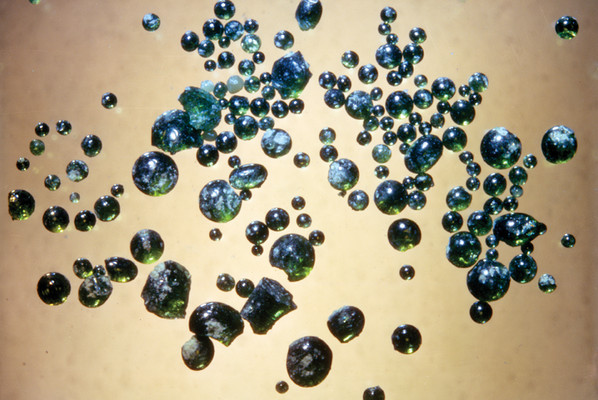
by Erin Wayman Thursday, January 5, 2012

Scientists used these small volcanic glass beads to determine that the moon's mantle once held water (and possibly still does). NASA
During the Apollo missions, NASA astronauts shoveled, bagged and sent back to Earth close to 400 kilograms of lunar rocks and soil. But researchers studying these samples never found water. Now, after decades of coming up dry, scientists have found evidence that the moon’s interior once held — and perhaps still holds — water.
For years, scientists pointed to the moon’s origins to explain its lack of water. A Mars-sized object slammed into Earth about 4.5 billion years ago, knocking off chunks of the planet that later formed the moon. Scientists speculate that the impact’s high heat drove off easily vaporized elements, such as hydrogen, from the impact debris.
But Alberto Saal, a geochemist at Brown University in Providence, R.I., didn’t buy the idea of a waterless moon. He teamed with Erik Hauri, a geochemist at the Carnegie Institution in Washington, D.C., James Van Orman, a geochemist at Case Western Reserve University in Cleveland, Ohio, and others to investigate volcanic glass beads from the moon that they thought might contain water. The beads, no larger than grains of sand, formed during fire fountain eruptions billions of years ago: A buildup of gas bubbles forced lava to fragment and explode through the moon’s surface, Saal says. As bits of lava reached the surface and cooled, they lost volatile gases and hardened. Using secondary ion mass spectrometry, a technique that can measure as little as 5 parts per million (ppm) of water, the team discovered minute amounts of water, up to 46 ppm, as well as other volatiles such as chlorine, fluorine and sulfur.
The team then worked backward to calculate how much water would have been in the lava when it first emerged from the moon’s mantle 3 billion years ago. The best estimate is 750 ppm, the researchers reported July 10 in Nature, but that value could be as low as 250 ppm.
Magma oozing from Earth’s mid-ocean ridges also has about 750 ppm of water, Saal says, so it’s possible the moon’s mantle holds as much water as Earth’s depleted upper mantle. But he and his colleagues only analyzed beads recovered from two locations on the moon during the Apollo 15 and 17 missions. Without analyzing beads from all over the moon, he says, it’s premature to estimate how much water the moon had, or still has.
“This evidence of water is exciting, but it’s not entirely unexpected,” says Larry Taylor, a geochemist at the University of Tennessee in Knoxville, who attempted more than a decade ago to identify water in similar lunar beads using less sensitive techniques. “It was bound to happen with advances in new technology.” Water on the moon makes sense because volatiles, such as water, are needed to form the bubbles in fire fountain eruptions, says Paul Spudis, a geologist at the Lunar and Planetary Institute in Houston, Texas. But because of the lack of evidence, scientists had presumed carbon monoxide was the cause, he says.
Now with water’s presence on the moon confirmed, scientists can consider how the water got there. Hauri envisions two likely scenarios. First, the impact that formed the moon might have vaporized Earth’s water, but the planet’s gravity could have held onto the gas, creating a steamy atmosphere. As the impact debris that later formed the moon orbited Earth, it could have collected some of the steam. Alternatively, he says, meteorites could have brought water to the moon during its formative years. One way to test these scenarios, Saal says, is to compare the isotopic composition of volatiles in the lunar beads to samples from Earth to see how well they correlate.
© 2008-2021. All rights reserved. Any copying, redistribution or retransmission of any of the contents of this service without the expressed written permission of the American Geosciences Institute is expressly prohibited. Click here for all copyright requests.